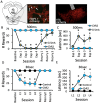This is a preprint.
Pumping the brakes: rostromedial tegmental inhibition of compulsive cocaine seeking
- PMID: 38405989
- PMCID: PMC10889025
- DOI: 10.1101/2023.10.04.560908
Pumping the brakes: rostromedial tegmental inhibition of compulsive cocaine seeking
Abstract
Addiction is marked by aberrant decision-making and an inability to suppress inappropriate and often dangerous behaviors. We previously demonstrated that inactivation of the rostromedial tegmental nucleus (RMTg) in rats causes persistent food seeking despite impending aversive footshock, an effect strikingly similar to the punishment resistance observed in people with a history of protracted drug use [1]. Here, we extend these studies to demonstrate chemogenetic silencing of RMTg axonal projections to the ventral tegmental area (VTA) (RMTg→VTA pathway) causes rats to endure significantly more footshock to receive cocaine infusions. To further test whether activation of this circuit is sufficient to suppress reward seeking in the absence of an overtly aversive stimulus, we used temporally specific optogenetic stimulation of the RMTg→VTA pathway as a "punisher" in place of footshock following lever pressing for either food or cocaine reward. While optical stimulation of the RMTg→VTA pathway robustly suppressed lever pressing for food, we found that stimulation of this circuit had only modest effects on suppressing responding for cocaine infusions. Even though optical RMTg→VTA stimulation was not particularly effective at reducing ongoing cocaine use, this experience nevertheless had long-lasting consequences, as reinstatement of drug seeking in response to cocaine-associated cues was profoundly suppressed when tested nearly two weeks later. These results suggest the RMTg may serve as a useful target for producing enduring reductions in drug craving, particularly during periods of abstinence from drug use.
Conflict of interest statement
Competing Interests The authors have no competing interests to disclose.
Figures




References
-
- Jentsch J.D. and Taylor J.R., Impulsivity resulting from frontostriatal dysfunction in drug abuse: implications for the control of behavior by reward-related stimuli. Psychopharmacology (Berl), 1999. 146(4): p. 373–90. - PubMed
-
- Solinas M., et al., Dopamine and addiction: what have we learned from 40 years of research. J Neural Transm (Vienna), 2019. 126(4): p. 481–516. - PubMed
Publication types
Grants and funding
LinkOut - more resources
Full Text Sources
